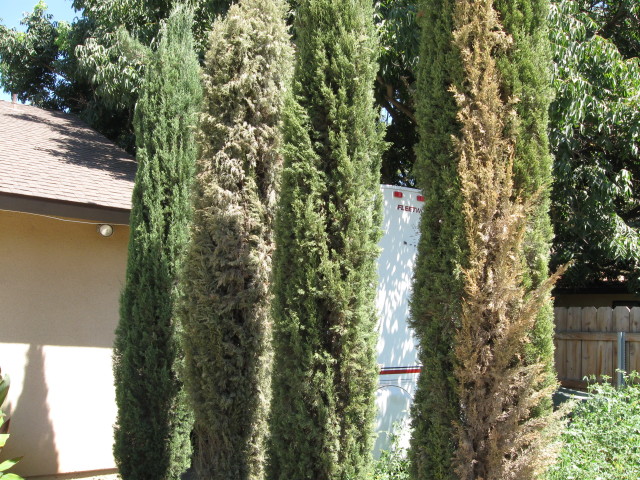Question
 Cypress Tree
Cypress Tree
We believe we have Italian cypress (5) planted in a row
2 of them have dying branches the othr 3 are healthy. They get the same water/sun and are aprox 15' tall (topped) and about 10+ years old so are mature.
On one tree, a branch going all the way to the top is completely dead, the other one the needles are drying and falling off. Our landscaper suggested a beatle as the culprit. What would be your educated guess?
AnswerLooks like it could be a canker disease rather than an insect.
Cypress canker is a spore-born disease that infects the Italian cypress through natural and man-made wounds. This fungal disease travels by wind and rain, infecting the Italian cypress during the cool, rainy periods. The infection passes through the wounds of the tree and settles in the bark and cambium of the tree. The foliage of the infected Italian cypress will experience yellowing near the area of infection while the uninfected areas remain green. The infection continues to spread throughout the tree until the entire tree dies.
Prevention
Cypress canker can be a fatal diseases that have no cure. Therefore, it is important to take preventative precautions to avoid infection. Providing your tree with the environment and care is the best protection. Always plant your Italian cypress tree in an area that receives a full, direct sunlight. The soil should be well-drained and porous to allow good air circulation throughout the soil. A medium to thick layer of mulch will keep the soil cool and moist, which also aides in maintaining proper circulation throughout the tree. Furthermore, it is important to avoid planting your Italian cypress tree in locations in which other trees have become infected. The fungal spores of phytophthora can thrive in the soil of the infected area for several years without a host.
Control
The infected Italian cypress tree can thrive for several seasons after an infection, if the disease is controlled. Pruning infected branches from the tree will redirect the tree's energy to more viable areas. The pruning should be completed with sterile pruning shears or saws that are sterilized between each cut. This will help to prevent the infection from spreading to other areas of the tree. In addition, fungicidal spray treatments can be helpful in controlling the infection, through it will not cure the infection.






